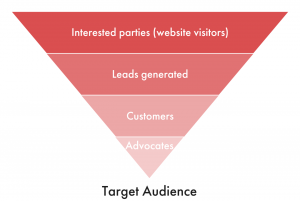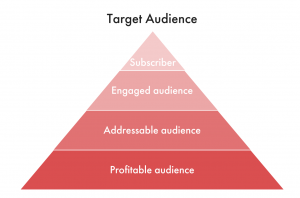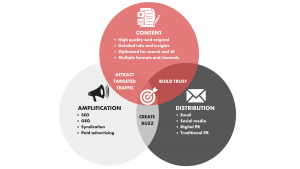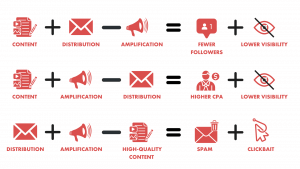Making the case for an integrated content marketing strategy
It’s happening again. Marketers are losing their minds over the latest shiny thing. This time it’s the Artificial Intelligence edition.
Remember when social media was going to revolutionise marketing? How it was going to put you in the PR driver’s seat and let you totally control your message?
Content marketing was supposed to replace media. You would be your own publisher, cut out the middleman, and totally control your message.
Search engine marketing would replace advertising – and let you totally control your message.
This time around, the promise of AI is huge – efficiency, cost reduction, automation, hyper-personalisation, and the ability to do it all easily and at scale. The lure is you can totally control your message – and everything else. The stakes are higher, simply because AI has infiltrated every corner of modern marketing.
Anyone familiar with the Gartner Hype Cycle knows how this plays out. All these glittering promises will deliver value, but not to the extent or with the ease leadership (and marketers) expect. Disillusionment sets in. Unintended consequences crop up. It takes a lot of experimentation and tenacity to realise results.
Except you never get to totally control your message – at least not for free. And that is the key to why marketers chase the hype. They’re hoping for lower costs, better performance, and a higher ROI.
The hidden cost of chasing performance
Ashnu Daswani writes about the grind of performance marketing in a post at Blue Ocean. She said marketers gain the illusion of control with metrics and measurement, but drift away from what matters most: brand building. We lose our creative streak. We stop building trust. We quit connecting with our customers.
It’s a race to the bottom, aided by a swath of optimisations, dashboards, and spreadsheets – all showing positive progress against siloed goals.
Brands must adopt integrated strategies, whether they like it or not.
But here’s the thing no one can ignore. AI cuts across every part of modern marketing. It’s laying waste to long-term debates about the good, better, and best ways to go to market. The immediate effects include:
- the death of the inbound vs outbound debate
- the uselessness of strategies for independent channels and disciplines
- a new evolution of search marketing
- siloed attribution models being rendered meaningless
SALT knows success in the age of AI requires all marketing functions to operate as one, interdependent team. That’s why we’re launching content marketing services.
What is content marketing?
The three core components of content marketing are having an integrated strategy, attracting and retaining a clearly defined audience, and driving profitable customer action.
It should not focus on what makes consumers react, such as entertainment and outrage. Content marketing should focus on what drives decisions.
The full definition from the Content Marketing Institute is:
“Content marketing is a strategic marketing approach focused on creating and distributing valuable, relevant, and consistent content to attract and retain a clearly defined audience — and, ultimately, to drive profitable customer action.”
For content marketing to be profitable, it must have a strategy and follow that strategy closely. To determine success, the strategy must be guided by business goals and have measurable targets.
What are the main objectives of content marketing?
Marketers should focus on two main things to drive success in content marketing:
- Build an audience of subscribers who have given you permission to market to them.
- Build content brands that become long-term business assets for your company.


The first step of building your own audience is to turn the marketing funnel upside down. The goal is to drive subscriptions, not traffic. As you develop trust with the people in your list, they increase in value. As that trust evolves and deepens over time, they ultimately become profitable.
Brands must have a keen understanding of their audience and what motivates them to make profitable contributions. It might not be a direct sale, but it could include customer referrals or writing recommendations.
An email marketing list is the most valuable subscriber asset, followed closely by a print mailing list. Fans and followers can also be worth pursuing, but you rarely have visibility over the algorithms that govern those lists. They can change without notice, which can crush your ROI.
Creating long-term assets, not quick hits of engagement
The next job for content marketing is to determine where to invest your creative efforts. What does your target audience value? What can you create to attract and retain their attention? When you’re consistently delivering essential information in a format they like, you create a brand asset that has its own value.
Before you create anything, it’s essential to get your messaging right. Finding the intersection between what they want to hear and what you want to tell them will inform your choices. Ensuring you’re doing it better or differently from your competitors increases your chances of success.
What does an integrated content marketing strategy look like?
In 2025, only 28% of enterprise marketers say their content strategy is extremely or very effective. Data, measurement, and SEO are all areas where marketers are struggling, which points to a lack of integration.
There are three components to an integrated marketing strategy, each one dependent on the others for maximum effectiveness.
- Content: Original, high-quality information and education designed to attract and retain the attention of your target audience. Content may be consumed online, offline, or even in person.
- Distribution: The ways used to deliver your content to your subscribers (people you know), including social media, email, PR, and digital PR.
- Amplification: Methods used to get your content in front of people you don’t know and who don’t know about you, including SEO/analytics, GEO, syndication, and paid advertising.

Content marketing in the age of AI
So what has AI changed when it comes to content marketing? It’s a fair question because there’s nothing groundbreaking about integrated marketing strategies. What is new, however, is the importance for brand marketers to operate as one team. It’s no longer a matter of being stronger together; it’s do or die.
Success in modern marketing comes when art – the human point of view and creativity – plus science (used responsibly and ethically) are equally balanced.
The proliferation of Generative AI (GenAI) content means brands have an opportunity to differentiate simply by being human. But creativity alone isn’t enough. In addition to search, each piece must be optimised for AI search. Content must be hyper-relevant to your audience for it to surface in search results. It has to be structured in a way Large Language Models (LLMs) can cite in AI overviews.
Because Google’s AI Mode is working towards more independence from search, brands must be prepared to deal with AI agents and levels of personalisation not seen before. Content and amplification are dependent on each other for success in ways they didn’t need to worry about in the past.
Why the ‘one team’ content marketing model is the only one that works
It’s no secret the internet is littered with great content nobody can find. Posting on social media without content is nothing more than networking (plus you’ll never be able to outperform the bots.) And SEO on its own drives traffic but it still needs a place for that traffic to land. A single tactic is not a strategy; it’s a silo.
Doubling up on tactics also delivers incomplete results. Either you’ll never grow your audience, you won’t get your content into the right hands, or you’ll end up spamming your brand messages far and wide.

SALT’s integrated content marketing strategies
For more than 10 years, SALT.agency has helped global brands achieve their business goals using aggressive organic growth strategies for SEO. We’ve expanded that focus to encompass a fully integrated approach to content, distribution and amplification.
Our deep knowledge of data, measurement and SEO makes us ideal partners for enterprise and B2B brands who want to move their marketing efforts from an expense into long-term brand assets. SALT is already developing groundbreaking tools to help brands gain visibility over where ChatGPT uses your content.
Let SALT help you with your content marketing strategy
If you’d like to know more about how SALT can help your business get in front of the AI challenge and deliver measurable results, get in touch. We’d love to have an obligation-free chat to explain our views on integrated strategies, developing brand assets, and building subscriber lists that will deliver value for years to come.